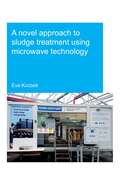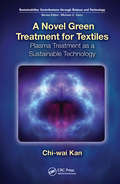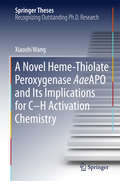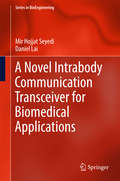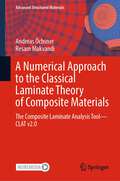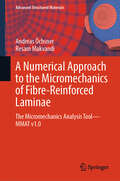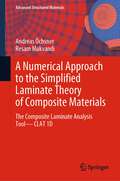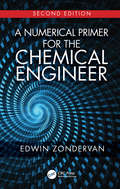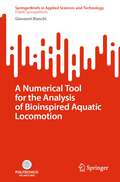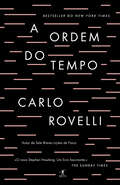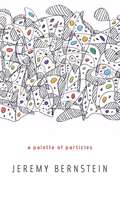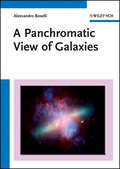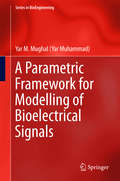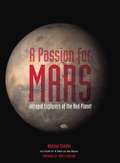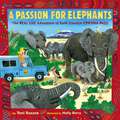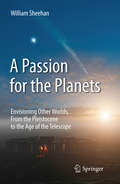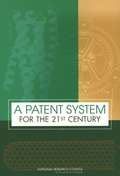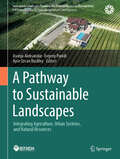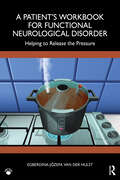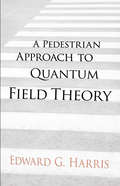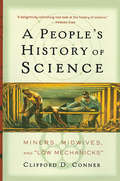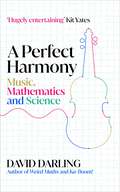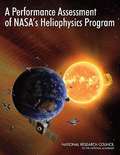- Table View
- List View
A Novel Approach to Sludge Treatment Using Microwave Technology (IHE Delft PhD Thesis Series)
by Eva KocbekSludge transportation costs can represent a large fraction of the expenses associated with municipal and faecal sludge management. These costs can be mitigated through the use of thermal drying approaches to reduce the sludge volume. This thesis described the application of a novel microwave-based pilot-scale unit as an alternative technology for the sanitisation and drying of sludge from municipal wastewater treatment plants and on-site sanitation facilities. The potential economic benefits of volumetric heating, moisture levelling, and increased liquid and vapour migration from the interior to the surface of the product underpins the increasing interest in the use of microwave technology during sludge treatment processes. According to the findings of this study, these factors lead to faster processing times, improved drying rates, and a reduced physical footprint. Furthermore, microwave technology operates as a standalone treatment unit. When coupled with mechanical dewatering techniques and membrane separation technology, it can increase the reliability of the technology employed in the treatment of sludge while recovering valuable resources through an agricultural or thermochemical application such as (co-) combustion. The results of this work demonstrate the strong feasibility of applying microwave-based technology within initiatives designed to protect the environment and safeguard public health.
A Novel Green Treatment for Textiles: Plasma Treatment as a Sustainable Technology (ISSN)
by Chi-wai KanIndustries worldwide have been impacted by environmental regulations, economics, and ultimately consumers, which has led to more thought about the development of sustainable products. The textile industry is no exception. The preparation, dyeing, and finishing of textile fibres requires large amounts of water and other chemicals which may be toxic
A Novel Heme-Thiolate Peroxygenase AaeAPO and Its Implications for C-H Activation Chemistry (Springer Theses)
by Xiaoshi WangIn this thesis, Xiaoshi Wang investigates the function and mechanism of a newly discovered heme-thiolate peroxygenase, AaeAPO. This enzyme class comes from Agrocybe aegerita and is used in the conversion of inert hydrocarbons to alcohols. Xiaoshi's work focuses on an extracellular P450 enzyme which is not limited in its stability and lack of solubility and therefore is relevant for widespread industrial use. The author demonstrates that the peroxygenase catalyzes a wide range of reactions. In some cases the author even describes very difficult transformations in molecules that are highly inert. Her detailed investigations provide a mechanistic framework for how the peroxygenase catalyzes such a large number of reactions. A major highlight of this thesis is the identification of key short-lived intermediates in the catalytic cycle of the peroxygenase, using rapid kinetic and spectroscopic methods, as well as the elucidation of the thermodynamic properties of these high-energy intermediates. This work adds new insight into an important class of enzymes.
A Novel Intrabody Communication Transceiver for Biomedical Applications (Series in BioEngineering)
by Mir Hojjat Seyedi Daniel LaiThis monograph explores Intrabody communication (IBC) as a novel non-RF wireless data communication technique using the human body itself as the communication channel or transmission medium. In particular, the book investigates Intrabody Communication considering limb joint effects within the transmission frequency range 0. 3-200 MHz. Based on in-vivo experiments which determine the effects of size, situations, and locations of joints on the IBC, the book proposes a new IBC circuit model explaining elbow joint effects. This model not only takes the limb joint effects of the body into account but also considers the influence of measurement equipment in higher frequency band thus predicting signal attenuation behavior over wider frequency ranges. Finally, this work proposes transmitter and receiver architectures for intrabody communication. A carrier-free scheme based on impulse radio for the IBC is implemented on a FPGA.
A Numerical Approach to the Classical Laminate Theory of Composite Materials: The Composite Laminate Analysis Tool—CLAT v2.0 (Advanced Structured Materials #189)
by Andreas Öchsner Resam MakvandiThis book first provides a systematic and thorough introduction to the classical laminate theory for composite materials based on the theory for plane elasticity elements and classical (shear-rigid) plate elements. The focus is on unidirectional lamina which can be described based on orthotropic constitutive equations and their composition to layered laminates. In addition to the elastic behavior, failure is investigated based on the maximum stress, maximum strain, Tsai-Hill, and the Tsai-Wu criteria.The solution of the fundamental equations of the classical laminate theory is connected with extensive matrix operations, and many problems require in addition iteration loops. Thus, a classical hand calculation of related problems is extremely time consuming. In order to facilitate the application of the classical laminate theory, we decided to provide a Python-based computational tool, the so-called Composite Laminate Analysis Tool (CLAT) to easily solve some standard questions from the context of fiber-reinforced composites. The tool runs in any standard web browser and offers a user-friendly interface with many post-processing options. The functionality comprises stress and strain analysis of lamina and laminates, derivation of off-axis elastic properties of lamina, and the failure analysis based on different criteria.
A Numerical Approach to the Micromechanics of Fibre-Reinforced Laminae: The Micromechanics Analysis Tool—MMAT v1.0 (Advanced Structured Materials #218)
by Andreas Öchsner Resam MakvandiThis book treats the micromechanics of laminae, i.e., the prediction of the macroscopic mechanical lamina properties based on the mechanical properties of the constituents, i.e., fibers and matrix. The focus is on unidirectional lamina which can be described based on orthotropic constitutive equations. In detail, predictions for the modulus of elasticity in and transverse to the fiber direction, the major Poisson’s ratio, as wells as the in-plane shear modulus are provided. The mechanics of materials approach, the elasticity solutions with contiguity after Tsai, and the Halpin-Tsai relationships, are presented in detail. Composite materials, especially fiber-reinforced composites, are gaining increasing importance since they can overcome the limits of many structures based on classical engineering materials. Particularly the combination of a matrix with fibers provides far better properties than the single constituents alone. A typical basic layer, the so-called lamina, can be composed of unidirectional fibers which are embedded in a matrix. In a second step, layers of laminae may be stacked under different fiber angles to a so-called laminate, which reveals—depending on the stacking sequence—different types of anisotropy/isotropy. A Python-based computational tool is provided, the so-called Micromechanics Analysis Tool (MMAT v1.0) to easily predict the elastic properties. The tool runs in any standard web browser and offers a user-friendly interface with many graphical representations of the elastic properties as a function of the fiber volume fraction.
A Numerical Approach to the Simplified Laminate Theory of Composite Materials: The Composite Laminate Analysis Tool—CLAT 1D (Advanced Structured Materials #202)
by Andreas Öchsner Resam MakvandiA typical approach to treat composite materials, which are composed of layered unidirectional lamina, is the so-called classical laminate theory (CLT). This theory is based on the theory for plane elasticity elements and classical (shear-rigid) plate elements under the assumption of orthotropic constitutive equations. The solution of the fundamental equations of the classical laminate theory is connected with extensive matrix operations and many problems require in addition iteration loops.This two-dimensional approach and the underlying advanced continuum mechanical modeling might be very challenging for some students, particularly at universities of applied sciences. Thus, a reduced approach, the so-called simplified classical laminate theory (SCLT), has been recently proposed. The idea was to use solely isotropic one-dimensional elements, i.e., a superposition of bar and beam elements, to introduce the major calculation steps of the classical laminate theory. Understanding this simplified theory is much easier and the final step it to highlight the differences when moving to the general two-dimensional case.This monograph first provides a systematic and thorough introduction to the simplified laminate theory based on the theory for bars and classical beam plate elements. The focus is on stacking of isotropic layers to simplified laminates. In addition to the elastic behavior, failure is investigated based on the maximum stress, maximum strain, Tsai-Hill, and the Tsai-Wu criteria. We provide a Python-based computational tool, the so-called Composite Laminate Analysis Tool (CLAT 1D) to easily solve some standard questions from the context of fiber reinforced composites. The tool runs in any standard web browser and offers a user-friendly interface with many post-processing options. The functionality comprises stress and strain analysis of simplified lamina and laminates and the failure analysis based on different criteria.
A Numerical Primer for the Chemical Engineer, Second Edition
by Edwin ZondervanDesigned as an introduction to numerical methods for students, this book combines mathematical correctness with numerical performance, and concentrates on numerical methods and problem solving. It applies actual numerical solution strategies to formulated process models to help identify and solve chemical engineering problems. Second edition comes with additional chapter on numerical integration and section on boundary value problems in the relevant chapter. Additional material on general modelling principles, mass/energy balances and separate section on DAE’s is also included. Case study section has been extended with additional examples.
A Numerical Tool for the Analysis of Bioinspired Aquatic Locomotion (SpringerBriefs in Applied Sciences and Technology)
by Giovanni BianchiThis book presents a novel method for the numerical simulation of swimming animals. It includes a review of the hydrodynamics of swimming, a description of the CFD model adopted, and a description of the results obtained by applying this model to the cownose ray. This method is developed for the open-source software OpenFOAM and relies on an overset mesh. A custom library is added to the solver to include the equations of the kinematics of the animal under investigation, combining the deformation of the fish fins with the computed displacement and rotation of the animal's body. The presented method helps investigate the dynamics of any animal moving in a fluid, provided that its kinematics is known, and in this work, it is applied to investigate the hydrodynamics of a cownose ray. This book is intended for researchers and engineers who aim to deeply understand the hydrodynamics of fish swimming and to design bioinspired autonomous underwater vehicles or novel propulsion systems.
A Ordem do Tempo
by Carlo Rovelli«A física moderna encontrou em Rovelli o seu poeta. Um livro cativante, fascinante, profundamente belo.»John Banville Do autor de Sete Breves lições de física, chega-nos um livro que mudará para sempre a nossa relação com a vida e com o Universo. «O novo Stephen Hawking. Um livro fascinante.»The Sunday Times O que é o tempo e até que ponto o compreendemos? Temos uma existência no tempo ou o tempo existe dentro de nós? O que significa a ideia do «correr» do tempo? Estará o passado realmente fechado e o futuro tão em aberto como julgamos? E o tempo existe, de facto?Numa abordagem luminosa e apaixonante, o físico Carlo Rovelli traz-nos um novo entendimento sobre o maior mistério da humanidade. Um mistério que diz respeito a todos nós, porque o experienciamos a todo o momento. O tempo. Escrito com a vitalidade poética que imprimira anteriormente a Sete breves lições de física, este é o ensaio científico e filosófico que mudará para sempre a nossa relação com a vida e com o Universo, porque para compreender o tempo precisamos de reflectir sobre nós. Combinando arte, filosofia e ciência, Carlo Rovelli transforma esta missão divulgadora sobre o mistério do tempo no maior dos prazeres, na mais bela das histórias. Carlo Rovelli é físico teórico e membro do Instituto Universitário de França e da Academia Internacional de Filosofia e das Ciências. Trabalhou em Itália, Estados Unidos e França. Com vários livros publicados na área, Sete Breves Lições de Física trouxe-lhe a merecida admiração de académicos e leigos, conquistando mais de um milhão de leitores à volta do mundo.
A Palette of Particles
by Jeremy BernsteinFrom molecules to stars, much of the cosmic canvas can be painted in brushstrokes of primary color: the protons, neutrons, and electrons we know so well. But for meticulous detail, we have to dip into exotic hues-leptons, mesons, hadrons, quarks. Bringing particle physics to life as few authors can, Jeremy Bernstein here unveils nature in all its subatomic splendor. In this graceful account, Bernstein guides us through high-energy physics from the early twentieth century to the present, including such highlights as the newly discovered Higgs boson. Beginning with Ernest Rutherford's 1911 explanation of the nucleus, a model of atomic structure emerged that sufficed until the 1930s, when new particles began to be theorized and experimentally confirmed. In the postwar period, the subatomic world exploded in a blaze of unexpected findings leading to the theory of the quark, in all its strange and charmed variations. An eyewitness to developments at Harvard University and the Institute for Advanced Study in Princeton, Bernstein laces his story with piquant anecdotes of such luminaries as Wolfgang Pauli, Murray Gell-Mann, and Sheldon Glashow. Surveying the dizzying landscape of contemporary physics, Bernstein remains optimistic about our ability to comprehend the secrets of the cosmos-even as its mysteries deepen. We now know that over eighty percent of the universe consists of matter we have never identified or detected. A Palette of Particles draws readers into the excitement of a field where the more we discover, the less we seem to know.
A Panchromatic View of Galaxies
by Alessandro BoselliDescribing how to investigate all kinds of galaxies through a multifrequency analysis, this text is divided into three different sections. The first describes the data currently available at different frequencies, from X-rays to UV, optical, infrared and radio millimetric and centimetric, while explaining their physical meaning. In the second section, the author explains how these data can be used to determine physical parameters and quantities, such as mass and temperature. The final section is devoted to describing how the derived quantities can be used in a multifrequency analysis to study such physical processes as the star formation cycle and constrain models of galaxy evolution. As a result, observers will be able to interpret galaxies and their structure.
A Pandemic Is Worldwide (Let's-Read-and-Find-Out Science 2)
by Sarah L. ThomsonRead and find out the science behind a pandemic and how to stay safe in this illustrated, informative nonfiction picture book. Everybody gets sick now and then—maybe with a runny nose or a sore throat. But sometimes, a lot of people get sick at once. If a disease spreads all over the world, that’s a pandemic. The current COVID-19 pandemic has upended the lives of kids across the world and has caused fear and confusion as people in charge have given conflicting orders. Read to discover the answers to some of your biggest questions, including:What is a pandemic? How are they created and spread? Has anything like this ever happened before? What is a coronavirus? What can we do to stay safe and healthy?While pandemics are rare, several have happened throughout the world’s history, such as the bubonic plague and smallpox, and our scientists have observed and learned some important lessons, such as the importance of vaccines.This Level 2 Let’s-Read-and-Find-Out shares important facts about past and current pandemics, taking readers from the origin of the word “quarantine” and through history’s many pandemics, to milestones such as the first vaccine that helped end smallpox.This book also comes with a handwashing diagram, a glossary, and a timeline of past pandemics and their impact on the world.This is a clear and appealing science book for early elementary age kids, both at home and in the classroom. It's a Level 2 Let's-Read-and-Find-Out, which means the book explores more challenging concepts for children in the primary grades. The 100+ titles in this leading nonfiction series are:hands-on and visualacclaimed and trustedgreat for classroomsTop 10 reasons to love LRFOs:Entertain and educate at the same timeHave appealing, child-centered topicsDevelopmentally appropriate for emerging readersFocused; answering questions instead of using survey approachEmploy engaging picture book quality illustrationsUse simple charts and graphics to improve visual literacy skillsFeature hands-on activities to engage young scientistsMeet national science education standardsWritten/illustrated by award-winning authors/illustrators & vetted by an expert in the fieldOver 130 titles in print, meeting a wide range of kids' scientific interestsBooks in this series support the Common Core Learning Standards, Next Generation Science Standards, and the Science, Technology, Engineering, and Math (STEM) standards. Let's-Read-and-Find-Out is the winner of the American Association for the Advancement of Science/Subaru Science Books & Films Prize for Outstanding Science Series.
A Parametric Framework for Modelling of Bioelectrical Signals (Series in BioEngineering)
by Yar M. MughalThis book examines non-invasive, electrical-based methods for disease diagnosis and assessment of heart function. In particular, a formalized signal model is proposed since this offers several advantages over methods that rely on measured data alone. By using a formalized representation, the parameters of the signal model can be easily manipulated and/or modified, thus providing mechanisms that allow researchers to reproduce and control such signals. In addition, having such a formalized signal model makes it possible to develop computer tools that can be used for manipulating and understanding how signal changes result from various heart conditions, as well as for generating input signals for experimenting with and evaluating the performance of e. g. signal extraction methods. The work focuses on bioelectrical information, particularly electrical bio-impedance (EBI). Once the EBI has been measured, the corresponding signals have to be modelled for analysis. This requires a structured approach in order to move from real measured data to the model of the corresponding signals. This book proposes a generic framework for this procedure. It can be used as a guide for modelling impedance cardiography (ICG) and impedance respirography (IRG) signals, as well as for developing the corresponding bio-impedance signal simulator (BISS).
A Passion For Mars: Intrepid Explorers of the Red Planet
by Andrew Chaikin James CameronThe quest for Mars is chronicled by bestselling author Andrew Chaikin in this story of a passionate band of Earthbound explorers caught in the irresistible pull of the Red Planet. They include celebrated figures: astronomer Carl Sagan, who champions the idea of life on Mars-; rocket scientist Wernher von Braun, drawing up plans for human Mars expeditions; and science-fiction author Ray Bradbury, standard-bearer for Mars's crucial place in human destiny. Readers also meet the rogue grad students known as the Mars Underground," keepers of the flame when Mars falls off NASA's radar; biologist Jerry Soffen, looking for signs of life in a Martian meteorite; geologist Mike Malin, who defies skeptics to reveal a Mars no one imagines; and many others, including Chaikin himself, who served on the first Viking Mars landing and covered Mars exploration as a science journalist. Based on extensive interviews, illustrated with compelling images, and animated by the author's own passion, Chaikin's account will resonate with anyone who has ever dreamed of a journey to Mars.
A Passion for Elephants: The Real Life Adventure of Field Scientist Cynthia Moss
by Toni BuzzeoA science and nature biography of Cynthia Moss, the elephant expert, by the author of Caldecott Honor book One Cool FriendCynthia Moss was never afraid of BIG things. As a kid, she loved to ride through the countryside on her tall horse. She loved to visit faraway places. And she especially loved to learn about nature and the world around her. So when Cynthia traveled to Africa and met the world’s most ENORMOUS land animal, the African elephant, at Amboseli National Park in Kenya, she knew she had found her life’s work.Cynthia has spent years learning everything she can about elephants and sharing these fascinating creatures with the world. She is a scientist, nature photographer, and animal-rights activist, fighting against the ivory poachers who kill so many elephants for their tusks.This lyrical and accessible picture book gives kids a glimpse of what scientists do in the real world and inspires them to dream of accomplishing BIG things.
A Passion for the Planets: Envisioning Other Worlds, From the Pleistocene to the Age of the Telescope
by William SheehanAstronomy is by far the most popular of the physical sciences, enticing enough to become a major cultural preoccupation for many, and for some an enthralling scientific activity which veritably rules their lives. What is the nature of that seemingly unstoppable attraction? In this lively and compelling account, William Sheehan - professional psychiatrist, noted historian of astronomy, and incurable observer - explores the nature of that allure through the story of man's visual exploration of the planets. In this volume, the first of a trilogy, Sheehan starts with observational astronomy's profound and lasting effect on his own life, setting the points of embarkation for the journey to come. He travels across the historical landscape seeking the earliest origins of man's compulsion to observe the planets among the hunter gatherers of the upper palaeolithic, and traces the evolving story from the planetary records of the earliest cities, to Pharonic Egypt through to Hellenistic Greek astronomy culminating in Ptolemy. The necessity to observe played its part in the perceptual changes wrought by the Copernican revolution, as well as the observational advances achieved by such extraordinary characters as Tycho with his sharpest of eyes, and his luxurious practice of total astronomy. The two epochal advances published in 1609, both born through planetary observation, namely Kepler's discovery of the true nature of the orbit of Mars and Harriot and Galileo's observations of the Moon, have a pivotal place in this account. Sheehan weaves a rich tapestry of social and technological settings, patronage and personalities, equipment and skills, cosmologies and goals, motives and compulsions to try to explain why we have observed, and continue to observe, the planets. The compelling text of A Passion for the Planets is enhanced by the specially commissioned planetary artwork of Julian Baum, himself son of a noted planetary observer and historian of planetary observers, and Randall Rosenfeld. A Passion for the Planets will be of interest to all amateur astronomers; active planetary observers; armchair astronomers; those interested in the history of astronomy; the cultural history of science; and astronomical art.
A Patent System For The 21st Century
by National Research Council of the National AcademiesThe U.S. patent system is in an accelerating race with human ingenuity and investments in innovation. In many respects the system has responded with admirable flexibility, but the strain of continual technological change and the greater importance ascribed to patents in a knowledge economy are exposing weaknesses including questionable patent quality, rising transaction costs, impediments to the dissemination of information through patents, and international inconsistencies. A panel including a mix of legal expertise, economists, technologists, and university and corporate officials recommends significant changes in the way the patent system operates. A Patent System for the 21st Century urges creation of a mechanism for post-grant challenges to newly issued patents, reinvigoration of the non-obviousness standard to quality for a patent, strengthening of the U.S. Patent and Trademark Office, simplified and less costly litigation, harmonization of the U.S., European, and Japanese examination process, and protection of some research from patent infringement liability.
A Pathway to Sustainable Landscapes: Integrating Agriculture, Urban Systems, and Natural Resources (Sustainable Landscape Planning and Natural Resources Management)
by Ayse Ozcan Buckley Asonja Aleksandar Evgeny PanidiThis book presents a collection of revolutionary research and case studies exploring innovative approaches to sustainable landscape design, green infrastructure, agricultural systems, geospatial technologies, and the development of resilient and livable cities. As the world faces escalating environmental challenges stemming from climate change, resource depletion, and biodiversity loss, there is an urgent need to identify and implement sustainable solutions. This book contributes to this imperative by showcasing research that advances both theoretical and practical knowledge in key domains critical to environmental sustainability and community resilience. The contributions in this book highlight the crucial role that cities play in addressing the global sustainability crisis. As urban populations continue to grow, so too do the demands on infrastructure, resources, and energy systems. Reconciling these increasing urban pressures with the need to protect and restore natural ecosystems is a central focus of the research presented. The chapters explore novel applications of renewable energy, green infrastructure, regenerative agriculture, and geospatial technologies as means of cultivating more ecologically sound and livable cities. Furthermore, the interdisciplinary nature of the research, spanning disciplines such as urban planning, environmental science, and agricultural technology, underscores the multifaceted nature of the sustainability transition. Collectively, the insights and case studies offered in this book provide invaluable guidance for researchers, policymakers, and practitioners dedicated to realizing a more equitable and environmentally resilient future.
A Patient’s Workbook for Functional Neurological Disorder: Helping To Release the Pressure
by Egberdina-Józefa van der HulstThis self-help workbook offers guidance for people coping with functional neurological disorder (FND), as well as their partners, families, friends, and healthcare professionals. It uses a visual metaphor based on the groundbreaking new Pressure Cooker Model to help you understand the condition and to reduce the symptoms. Firmly rooted in neuropsychological principles, this model is practical and relatable, bridging the gap between theoretical and clinical models of FND.The Pressure Cooker Model focuses on the person with FND, as well as the contribution of the person’s environment, interactions, relationships, and surroundings to FND, and looks to improve recovery, reduce stigma and increase FND awareness, providing a radical shift in thinking about FND. Grounded in neuropsychology, this book helps people understand their FND triggers, as well as their emotional and physical symptoms, and offers many strategies for self-care and building healthy relationships.The book is accompanied by an extensive set of entirely free online resources and templates to help people with FND manage a range of genuine and disabling functional neurological symptoms, from motor symptoms (such as tremors, functional weakness, and gait difficulties, to sensory symptoms such as tingles and numbness, and cognitive symptoms such as memory and concentration difficulties or brain fog, and dissociative seizures. It is valuable reading for anyone with FND, their partners, families, and friends, as well as healthcare professionals in any field working with people with FND.
A Pedestrian Approach to Quantum Field Theory (Dover Books on Physics)
by Edward G HarrisWritten by a renowned professor of physics, this introductory text is geared toward graduate students taking a year-long course in quantum mechanics in which the third quarter is devoted to relativistic wave equations and field theory. Difficult concepts are introduced gradually, and the theory is applied to physically interesting problems. After an introductory chapter on the formation of quantum mechanics, the treatment advances to examinations of the quantum theory of the free electromagnetic field, the interaction of radiation and matter, second quantization, the interaction of quantized fields, and quantum electrodynamics. Additional topics include the theory of beta decay, particles that interact among themselves, quasi particles in plasmas and metals, and the problem of infinities in quantum electrodynamics. The Appendix contains selected answers to problems that appear throughout the text.
A People's History of Science: Miners, Midwives, and "Low Mechanicks"
by Clifford D. ConnerWe all know the history of science that we learned from grade school textbooks: How Galileo used his telescope to show that the earth was not the center of the universe; how Newton divined gravity from the falling apple; how Einstein unlocked the mysteries of time and space with a simple equation. This history is made up of long periods of ignorance and confusion, punctuated once an age by a brilliant thinker who puts it all together. These few tower over the ordinary mass of people, and in the traditional account, it is to them that we owe science in its entirety. This belief is wrong. A People's History of Science shows how ordinary people participate in creating science and have done so throughout history. It documents how the development of science has affected ordinary people, and how ordinary people perceived that development. It would be wrong to claim that the formulation of quantum theory or the structure of DNA can be credited directly to artisans or peasants, but if modern science is likened to a skyscraper, then those twentieth-century triumphs are the sophisticated filigrees at its pinnacle that are supported by the massive foundation created by the rest of us.
A Perfect Harmony: Music, Mathematics and Science
by David DarlingFrom the earliest of civilisations, humans have found ways to make music, whether through makeshift drums or artfully drilled bone flutes. But how did music – effectively little more than a series of certain tones and rhythms – become so integral to the human experience? Untangling the curious links between notes and number, musical perception, psychology and physics, David Darling examines the fascinating science behind music, from its Palaeolithic origins to the present. Revealing surprising connections and busting pervasive myths, A Perfect Harmony asks: Why do musicians tend to be better at maths than non-musicians? Why do we find some pieces sad and others happy? Will playing Mozart to babies predispose them to genius? Could an AI write the perfect symphony?
A Performance Assessment Of Nasa's Astrophysics Program
by National Research Council of the National AcademiesWhile a number of remarkable discoveries in astronomy and astrophysics have taken place over the past 20 years, many important questions remain. Continued progress in these fields will require NASA’s leadership. To help determine if NASA can meet this challenge, Congress, in the 2005 NASA Authorization Act, directed the agency to have "[t]he performance of each division in the Science directorate...reviewed and assessed by the National Academy of Sciences at 5-year intervals." In early 2006, NASA asked the NRC to conduct such an assessment for the agency’s Astrophysics Division. This report presents an assessment of how well NASA’s current program addresses the strategies, goals, and priorities outlined in previous Academy reports. The report provides an analysis of progress toward realizing these strategies, goals, and priorities; and a discussion of actions that could be taken to optimize the scientific value of the program in the context of current and forecasted resources.
A Performance Assessment of NASA's Heliophysics Program
by National Research Council of the National AcademiesSince the 1990s, the pace of discovery in the field of solar and space physics has accelerated, largely owing to NASA investments in its Heliophysics Great Observatory fleet of spacecraft. These enable researchers to investigate connections between events on the Sun and in the space environment by combining multiple points of view. Recognizing the importance of observations of the Sun-to-Earth system, the National Research Council produced a solar and space physics decadal survey in 2003, laying out the Integrated Research Strategy. This strategy provided a prioritized list of flight missions, plus theory and modeling programs, that would advance the relevant physical theories, incorporate those theories in models that describe a system of interactions between the Sun and the space environment, obtain data on the system, and analyze and test the adequacy of the theories and models. Five years later, this book measures NASA's progress toward the goals and priorities laid out in the 2003 study. Unfortunately, very little of the recommended priorities will be realized before 2013. Mission cost growth, reordering of survey mission priorities, and unrealized budget assumptions have delayed nearly all of the recommended NASA spacecraft missions. The resulting loss of synergistic capabilities in space will constitute a serious impediment to future progress.
